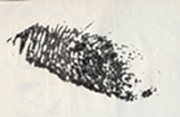Doubt in the Darlie Routier case: The fingerprints
August 17, 2012
I said in a previous blog that I would write about the Darlie Routier case again. The truth is I could write an entire book on this particular case and still not cover everything. Indeed, several people already have written books on the case and I feel comfortable saying there is still more to this complex story than most people realize.
There are many who believe that the state of Texas got it right when they prosecuted Darlie for the death of one of her two young boys, Damon. However, evidence has slowly emerged over the years that casts doubt on the theory presented by the prosecution at trial. Assistant District Attorney Greg Davis was adamant that the crime scene inside the Routier home was staged and that the sole person responsible for the murders of Devon and Damon was none other than their own mother.
Many people believed this theory when it was presented. They believed it in spite of the injuries Darlie sustained. Though a number of people testified that Darlie’s injuries were superficial, doctors who treated her at Baylor University Medical Center stated under oath that during exploratory surgery of her neck wound it was determined the knife had sliced within two millimeters of her carotid artery. Had the artery been severed, Darlie would have died without immediate treatment within minutes.
There is evidence to suggest someone outside of the Routier family entered it during the early morning hours of June 6th, 1996, before police responded to Darlie’s 911 call. I’ll begin with a discussion of the fingerprint evidence.
A single bloody fingerprint (sometimes referred to as a fingerprint or a partial palm print, though it looks like a fingerprint) was left on the glass table in the Routier’s family room the morning of the murders. At trial, Dallas police officer James Cron testified there was not enough detail to make an identification. He suggested the print was left by one of the two young boys.
The investigators working on the case failed to obtain the fingerprints of Devon and Damon to use for comparison purposes. Additionally, neither of the two medical examiners who conducted autopsies on the boys took their prints. In an attempt to put an end to speculation that the bloody print taken from the glass table belonged to one of the boys, the children were exhumed. Measurements of the childrens’ fingers were taken.
The children were buried together, holding hands. This, combined with the passage of time and conditions within the coffin, compromised the ability to collect the boys’ prints. However, some fingerprints were obtained, along with measurements.
Richard Jantz conducted an analysis of the print taken from the glass table. Jantz obtained his Ph. D in Anthropology from the University of Kansas. In 2002, Jantz signed an affidavit pertaining to his examination of the bloody print that had become known as exhibit 85-J. He explained in the report that the purpose of the examination was “to address the question of whether the fingerprint was made by an adult or a child.”
For the examination, Jantz compared the dimensions of fingerprints from a collection of dermatoglyphic prints for adults and children. Children’s prints made between the age of 4 years and 6.6 years were analyzed for the study. Jantz also had the fingerprint cards for the Routier children for consideration.
The fingerprint made in blood consisted of a whorl pattern. Jantz determined that Devon had a whorl pattern on one of his right fingers. Damon has a whorl pattern on his right thumb. When Jantz compared the dimensions of the latent fingerprint against Damon’s thumb and Devon’s finger, he determined that the value from core to flexion crease was almost 2 mm less than the fingerprint obtained from the Routier home for Devon, and over 3 mm less for Damon.
To break this down in simpler terms, Jantz provided a chart that contained the average measurements for individuals falling within specific classifications. Again, these were based on the collection of fingerprints I referred to above. The males in the sample had an average measurement of 14.285, from core to flexion crease. Females had an average of 12.306. Children between the ages of 4 years and 6.6 years had an average of 9.21. The bloody fingerprint measured 12.6.
Based on the data provided by Jantz, the latent print was not consistent with a young child. It appeared to be the most consistent with an adult female; however, it is important to note that a variation in measurements exist. Standard deviation, for the male measurements, was 1.881.
Jantz also looked at ridge breadth, which represents “ridges which run transversely across the finger between the pattern and the flexion crease.” Jantz also wrote, “It is obvious that the latent print has coarser ridges than either Damon’s thumb or Devon’s digit IV.” Those two digits were compared since they were the only ones containing whorl patterns. The average measurement in centimeters for adult males was 18.446, with a standard deviation of 2.231. For women, the measurement was an average of 20.386, with a standard deviation of 2.085. Finally, for children the average measurement was 27.322, with a standard deviation of 3.077. The latent print measured 20.6. Jantz concluded by stating, “The foregoing analysis is able to successfully identify the prints of the two known children, the thumb of Damon Routier, and digit IV from Devon Routier, as those of children. The latent print consistently has a higher probability of having been made by an adult. The probabilities range from 0.767 to 0.985, depending upon which character is used.”
Though Jantz’s report supports the defense’s contention that the print did not belong to either of the Routier children, it is not sufficient on its own to exclude Darlie Routier as the source of the print. The logical progression of thinking, on the part of the state and those convinced of Darlie’s guilt, was that the print belonged to Darlie.
In 2003, Robert Lohnes signed an affidavit wherein he described comparing Darlie Routier’s fingerprints to the latent bloody print obtained from the glass table. Previously, Lohnes worked as a latent print examiner from 1979 to 1996. He worked in conjuction with the New York City Major Case Squad and the Federal Bureau of Investigation Joint Bank Robbery Task Force. He taught homicide investigation courses and conducted training seminars on detection and recovery methods for latent prints. Lohnes compared the latent print to a print card containing Darlie’s fingerprints. After conducting analysis of the prints, Lohnes concluded that “No. 85-J was not made by the person from whom the fingerprints on Exhibit B were taken.”
Exhibit B consisted of Darlie Routier’s fingerprints. Lohnes was not contacted by the state or Darlie’s defense to make the comparison either; he was contacted by ABC News.
The prosecution responded by submitting the affidavit of Pat Wertheim who concluded that all of Darlie’s fingerprints were excluded except the the ring finger of her right hand. Wertheim claimed that finger could not be matched to the latent print, nor excluded.
One of the attorneys, Stephen Cooper, handling Darlie’s appeals told the media “no less than three other fingerprint experts have excluded Darlie as a possible source.” Cooper stated that Jantz was not included in the three experts who excluded the convicted woman as a source of the print.
Darlie’s attorneys also claimed, in her Writ of Habeas Corpus, that the above described fingerprint has been compared to law enforcement personnel who responded to the scene. The state has changed their theory to fit the crime and to fit evolving explanation of evidence based on advancements in expertise and science. The prosecution originally suggested the fingerprint was left by a child. When this claim was challenged the prosecution altered their theory by claiming Darlie was the contributor of the print. It appears the state has been unable to obtain a statement that definitively identifies Darlie as a source of the print. The best they have to offer is the contention that a single finger on Darlie’s right hand cannot be excluded or identified as the contributor. But what does that even mean? Does that finding have any value in light of other experts finding the print does not match Darlie?
In terms of fingerprint evidence, there appears to be more. In 2003, Darlie’s attorneys filed a renewed motion for the “testing of physical and biological evidence,” combined with a request for an evidentiary hearing. Two fingerprints were taken from the utility room door, leading to the garage of the Routier home. One print was made in blood and the other was not. The fingerprint below the bloody print was examined by Lohnes and identified as matching the middle finger of Darin’s left hand.
However, the motion states that two experts – Lohnes and a forensic fingerprint analyst named Glenn Langenburg – examined the same print to determine if Darlie could be identified or excluded as the source of the print. Both experts excluded her. The experts did not agree as to whether or not Darin was the source of the print, however. Langenburg’s assessment differed from Lohnes’ in that it excluded Darin as the contributor.
In 2008, the federal court granted Darlie’s request to test evidence, in part. Regarding the fingerprint evidence, the motion stated the following: “The bloody fingerprint deserves to be examined with the most modern techniques available. The same is true for the fingerprints marked as State Exhibit nos 85-F and 85-G.” The bloody print refers to the first piece of evidence discussed above which consisted of a fingerprint located on the glass table. However, this has been put on hold until Texas is finished with other approved testing.
In another motion, filed in 2008, Darlie’s defense asked that the court grant the request to run the fingerprint evidence through all available fingerprint databases. The defense added, “As with the DNA testing, any identification of this print as belonging to a male outside the Routier family will provide powerful corroboration of Ms. Routier’s account.”
Indeed it would. It would destroy the prosecution’s theory that there was not an intruder as Darlie claimed. If any of the prints are run through a fingerprint database and match someone outside the Routier home, who was in the area at the time, it would mean an intruder did enter the family home. If there is a match to either of the bloody fingerprints, to someone outside the immediate family, it means they were present during the attacks because the prints were made in blood.
I placed a photograph of the print made in blood, left on the glass table, on Exhibit B (the fingerprint card used to compare Darlie Routier’s prints to those found in the home). Click on the picture to see the larger version.
In addition to possibly matching one or more prints to someone outside of the Routier home, there is also the chance that DNA tests may be successful in extrapolating DNA belonging to a non-family member. DNA tests are currently far more sophisticated than they were in 1996 and 1997, when the crimes originally occurred and when Darlie was tried in the death of Damon.
DNA testing (and retesting) was approved for a number of items. In April of 2012, the court ordered the materials be delivered to the Department of Public Safety Laboratory no later than the 23rd of May. The court ordered that the testing take place in a “timely and efficient manner”.
It is now mid August of 2012.
Some may deny there is any doubt at all in this case, but I feel that people who take the time to review all of the available evidence will find it difficult to conclude that there is not reasonable doubt. Others who read through the evidence – particularly those who have witnessed the aftermath of wrongful convictions (some of which have been corrected) – are likely to come to the realization that justice was not served in this case.
Two little boys died horrific deaths and their mother is on death row for the crime. Texas has executed people in situations where there was considerable doubt about their actual guilt. Johnny Garrett is merely one example. Texas has even gone to great lengths to keep the truth from surfacing. In Garrett’s case, the state threatened to take legal action against the family if they pursued DNA testing to prove his innocence after his execution had already taken place. That particular case is chronicled in a documentary called “The Last Word”. Though low budget, the film is a cautionary tale about the rush to justice that occurs in some situations, resulting in the delay or denial of justice.
There is much more evidence and information worth examining in this case. I have decided that the best thing to do is to break this down into smaller descriptions over time.
The most salient question that remains in this case is this: Should any state carry out an execution when there are serious doubt as to whether or not the person committed the crime?
More importantly, now that you know there is doubt are you comfortable standing by and merely hoping that the wheels of justice eventually move in the right direction?
I’m not. I hope there are many more who feel as I do.
More information about Darlie’s case may be found on the site managed by her mother, Darlie Kee: http://www.fordarlieroutier.org/
Additional information is also included on this site: http://www.routiertranscripts.com/




You must be logged in to post a comment.